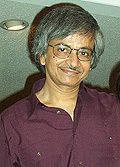Nanoelectronics and the Meaning of Resistance
Newer version available
Category
Published on
Abstract
 |
The purpose of this series of lectures is to introduce the "bottom-up" approach to nanoelectronics using concrete examples. No prior knowledge of quantum mechanics or statistical mechanics is assumed; however, familiarity with matrix algebra will be helpful for some topics.
Day 1: What and where is the resistance?
Day 2: Quantum transport
Day 3: Spins and magnets
Day 4: Maxwell's demon
Day 5: Correlations and entanglement
Romanian translation of this page.
Bio
 Supriyo Datta received his B.Tech. from the Indian Institute of Technology in Kharagpur, India in 1975 and his Ph.D. from the University of Illinois at Urbana-Champaign in 1979. In 1981, he joined Purdue University, where he is (since 1999) the Thomas Duncan Distinguished Professor in the School of Electrical and Computer Engineering. He started his career in the field of ultrasonics and was selected by the Ultrasonics group as its outstanding young engineer to receive an IEEE Centennial Key to the Future Award and by the ASEE to receive the Terman Award for his book on Surface Acoustic Wave Devices.
Supriyo Datta received his B.Tech. from the Indian Institute of Technology in Kharagpur, India in 1975 and his Ph.D. from the University of Illinois at Urbana-Champaign in 1979. In 1981, he joined Purdue University, where he is (since 1999) the Thomas Duncan Distinguished Professor in the School of Electrical and Computer Engineering. He started his career in the field of ultrasonics and was selected by the Ultrasonics group as its outstanding young engineer to receive an IEEE Centennial Key to the Future Award and by the ASEE to receive the Terman Award for his book on Surface Acoustic Wave Devices.
Since 1985 he has focused on current flow in nanoscale electronic devices and is well-known for his contributions to spin electronics and molecular electronics. Datta's most important contribution, however, is the approach his group has pioneered for the description of quantum transport far from equilibrium, combining the non-equlibrium Green function (NEGF) formalism of many-body physics with the Landauer formalism from mesoscopic physics as described in his books Electronic Transport in Mesoscopic Systems (Cambridge, 1995), and Quantum Transport: Atom to Transistor (Cambridge, 2005).
Datta's unique approach to the problem of quantum transport has not only had a significant impact on nanoelectronics research but also on graduate and undergraduate curriculum development in the area. He is a Fellow of the American Physical Society (APS) as well as the Institute of Electrical and Electronics Engineers (IEEE) and has received IEEE Technical Field Awards both for research and for graduate teaching.
Sponsored by
NCN@Purdue Summer School 2008 National Science Fondation Intel Corporation
Publications

Quantum Transport: Atom to Transistor
by Supriyo Datta (Cambridge - July 11, 2005)
This book presents a unique approach to the fundamentals of quantum transport, and is aimed at senior undergraduate and graduate students. Some of the most advanced concepts of non-equilibrium statistical mechanics are included and yet no prior acquaintance with quantum mechanics is assumed.
Cite this work
Researchers should cite this work as follows: